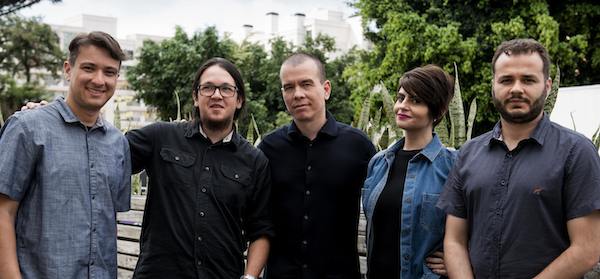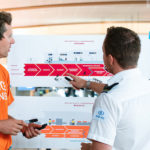
The designers and innovators at EGGS Design in Curitiba, Brazil, see great potential for increased customer centricity and innovation for Brazilian companies. From left: Victor Stelmasuk, Victor Santos, Sandro Valdrighi, Analuiza Camargo and Pedro Gonzalez.
With a below-average ranking on the Global Innovation Index 2016 – coming 69th out of 128 countries – Brazilian companies must find new ways to grow if they are to excel. One option is for them to re-think their strategy by improving how they interact with customers. By understanding customer’s needs and designing services that meet these needs, companies not only increase their chances of surviving the economic crisis, but are positioned to serve when consumer confidence and spending power rises again.
“To achieve growth, I see that raising productivity and competitiveness are the main challenges for Brazilian companies,” states Victor Stelmasuk from EGGS Design. “People’s purchasing power is reduced in Brazil due to the deep recession. For companies to be able to succeed in this market it is important that they align their services and offerings to what Brazilians need, and can currently afford.”
Innovate or die
Competition throughout all sectors in Brazil is fierce, so positive differentiation through good customer experiences is a key to success. A method that can ensure this is called service design. Over the last 10 years, service design has become an established form for service innovation throughout Europe and North America. This method has already contributed to growth and increased customer satisfaction for many Norwegian service providers.
It is all about understanding the users
Service design is about looking at everything from the perspective of the users of a service, and ensuring that the service meets their actual needs and expectations. Having empathy with the user’s situation is key to being able to design attractive and user-friendly services. A user can be a customer of a service, a buyer of a product, a guest at a restaurant, a passenger at an airport, a patient receiving health services or staff of any of these service providers.
A holistic perspective on the customer journey
“A successful service is also about orchestrating all points of contact a user has with a service, so that the user has a seamless experience. We call this the customer journey,” explains Stelmasuk. These points of contact can be a website, a booking service, a store or restaurant, an app and the staff enabling the services.

Understanding the user is an important part of the process. Photo courtesy of EGGS Design.
High rankings due to traveller centricity at Oslo Airport
“We have worked with Oslo Airport on several projects since 2013. At present, we are in the final phase of finishing our current project within Terminal 2, which opens in April 2017. The common denominator has been to shift the organisation’s mind-set towards traveller centricity, ensuring that all services improve people’s experience when travelling through the airport,” says designer Victor Stelmasuk.
From the most efficient to best
Oslo Airport’s ambition is to be the best and most efficient airport in Europe.
“In 2013, we did the service design project, The Traveller’s Experience, where we conducted many methods from service design. This was so we could gain maximum insight into the passenger’s needs, mind-sets and mode. Furthermore, we created services, and orchestrated a mind-set that all staff at the airport must have so that passengers receive the best experiences when travelling through Oslo Airport, Gardemoen.
Creating an airport where all staff understand the situations and the different needs passengers have and catering accordingly with these needs, has been key for OSL’s high ratings and customer satisfaction,” concludes Victor Stelmasuk.
About EGGS
•Multi-disciplinary design and innovation agency
•Expertise in service design, graphic design, digital design and branding
•Established 2015 in Brazil, and 2012 in Norway by the merging of two smaller design agencies
•Seven employees (70 world-wide)
•Based in Curitiba Brazil, also offices in three cities in Norway, with a 5th office opening FW 2017.
•Financially sound, steady growth and positive financial results
•www.eggsdesign.com
:






